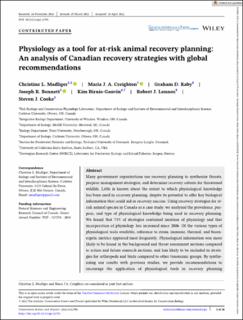Physiology as a tool for at-risk animal recovery planning: An analysis of Canadian recovery strategies with global recommendations
| dc.contributor.author | Madliger, Christine L. | |
| dc.contributor.author | Creighton, Maria J. A. | |
| dc.contributor.author | Raby, Graham D. | |
| dc.contributor.author | Bennett, Joseph R. | |
| dc.contributor.author | Birnie-Gauvin, Kim | |
| dc.contributor.author | Lennox, Robert | |
| dc.contributor.author | Cooke, Steven J. | |
| dc.date.accessioned | 2023-02-13T08:55:53Z | |
| dc.date.available | 2023-02-13T08:55:53Z | |
| dc.date.created | 2022-09-30T13:32:03Z | |
| dc.date.issued | 2022 | |
| dc.identifier.citation | Conservation Science and Practice (CSP). 2022, 4 (6), . | en_US |
| dc.identifier.issn | 2578-4854 | |
| dc.identifier.uri | https://hdl.handle.net/11250/3050260 | |
| dc.description.abstract | Many government organizations use recovery planning to synthesize threats, propose management strategies, and determine recovery criteria for threatened wildlife. Little is known about the extent to which physiological knowledge has been used in recovery planning, despite its potential to offer key biological information that could aid in recovery success. Using recovery strategies for at-risk animal species in Canada as a case study, we analyzed the prevalence, purpose, and type of physiological knowledge being used in recovery planning. We found that 73% of strategies contained mention of physiology and that incorporation of physiology has increased since 2006. Of the various types of physiological tools available, reference to stress, immune, thermal, and bioenergetic metrics appeared most frequently. Physiological information was more likely to be found in the background and threat assessment sections compared to action and future research sections, and less likely to be included in strategies for arthropods and birds compared to other taxonomic groups. By synthesizing our results with previous studies, we provide recommendations to encourage the application of physiological tools in recovery planning worldwide, such as increased incorporation of physiology in ongoing threat monitoring, critical habitat assessments, monitoring the success of recovery actions, and modeling responses to future environmental changes. | en_US |
| dc.language.iso | eng | en_US |
| dc.rights | Navngivelse 4.0 Internasjonal | * |
| dc.rights.uri | http://creativecommons.org/licenses/by/4.0/deed.no | * |
| dc.title | Physiology as a tool for at-risk animal recovery planning: An analysis of Canadian recovery strategies with global recommendations | en_US |
| dc.title.alternative | Physiology as a tool for at-risk animal recovery planning: An analysis of Canadian recovery strategies with global recommendations | en_US |
| dc.type | Peer reviewed | en_US |
| dc.type | Journal article | en_US |
| dc.rights.holder | © 2022 The Authors | en_US |
| dc.description.version | publishedVersion | en_US |
| cristin.ispublished | true | |
| cristin.fulltext | original | |
| cristin.qualitycode | 1 | |
| dc.identifier.doi | 10.1111/csp2.12701 | |
| dc.identifier.cristin | 2057227 | |
| dc.source.journal | Conservation Science and Practice (CSP) | en_US |
| dc.source.volume | 4 | en_US |
| dc.source.issue | 6 | en_US |
| dc.source.pagenumber | 0 | en_US |

